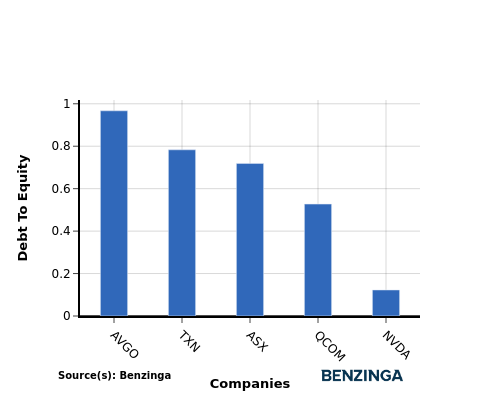Exploring The Competitive Space: NVIDIA Versus Industry Peers In Semiconductors & Semiconductor Equipment
In the dynamic and cutthroat world of business, conducting thorough company analysis is essential for investors and industry experts. In this article, we will undertake a comprehensive industry comparison, evaluating NVIDIA (NASDAQ:NVDA) and its primary competitors in the Semiconductors & Semiconductor Equipment industry. By closely examining key financial metrics, market position, and growth prospects, our aim is to provide valuable insights for investors and shed light on company's performance within the industry.
NVIDIA Background
Nvidia is a leading developer of graphics processing units. Traditionally, GPUs were used to enhance the experience on computing platforms, most notably in gaming applications on PCs. GPU use cases have since emerged as important semiconductors used in artificial intelligence. Nvidia not only offers AI GPUs, but also a software platform, Cuda, used for AI model development and training. Nvidia is also expanding its data center networking solutions, helping to tie GPUs together to handle complex workloads.
| Company | P/E | P/B | P/S | ROE | EBITDA (in billions) | Gross Profit (in billions) | Revenue Growth |
|---|---|---|---|---|---|---|---|
| NVIDIA Corp | 51.61 | 46.54 | 26.65 | 23.01% | $22.58 | $26.67 | 69.18% |
| Broadcom Inc | 99.20 | 18.37 | 23.01 | 7.12% | $8.02 | $10.2 | 20.16% |
| Taiwan Semiconductor Manufacturing Co Ltd | 26.42 | 7.49 | 10.88 | 8.19% | $608.71 | $493.4 | 41.61% |
| Advanced Micro Devices Inc | 100.60 | 3.86 | 8.11 | 1.23% | $1.59 | $3.74 | 35.9% |
| Texas Instruments Inc | 41.03 | 12 | 12.40 | 7.08% | $1.85 | $2.31 | 11.14% |
| Qualcomm Inc | 16.27 | 6.31 | 4.24 | 10.3% | $3.67 | $6.04 | 16.93% |
| ARM Holdings PLC | 197.05 | 22.89 | 39.21 | 3.17% | $0.46 | $1.21 | 33.73% |
| Micron Technology Inc | 22.42 | 2.74 | 4.17 | 3.79% | $4.33 | $3.51 | 36.56% |
| Analog Devices Inc | 66.62 | 3.47 | 12.45 | 1.63% | $1.2 | $1.61 | 22.28% |
| Monolithic Power Systems Inc | 20.31 | 11.16 | 15.50 | 4.17% | $0.18 | $0.35 | 39.24% |
| STMicroelectronics NV | 27.56 | 1.64 | 2.47 | 0.32% | $0.51 | $0.84 | -27.36% |
| ON Semiconductor Corp | 40.01 | 3 | 3.71 | -5.78% | $-0.37 | $0.29 | -22.39% |
| ASE Technology Holding Co Ltd | 19.55 | 2.06 | 1.07 | 2.39% | $27.16 | $24.89 | 11.56% |
| United Microelectronics Corp | 11.85 | 1.42 | 2.32 | 2.06% | $23.86 | $15.45 | 5.91% |
| First Solar Inc | 14.06 | 2.17 | 4.18 | 2.59% | $0.35 | $0.34 | 6.35% |
| Credo Technology Group Holding Ltd | 321.93 | 23.51 | 38.72 | 5.63% | $0.04 | $0.11 | 179.73% |
| Skyworks Solutions Inc | 30.45 | 1.97 | 3.17 | 1.11% | $0.22 | $0.39 | -8.87% |
| Qorvo Inc | 151.78 | 2.41 | 2.26 | 0.93% | $0.11 | $0.37 | -7.6% |
| Universal Display Corp | 33.05 | 4.55 | 11.68 | 3.93% | $0.08 | $0.13 | 0.62% |
| Lattice Semiconductor Corp | 145 | 10.42 | 15.17 | 0.71% | $0.02 | $0.08 | -14.68% |
| Average | 72.9 | 7.44 | 11.3 | 3.19% | $35.89 | $29.75 | 20.04% |
Through a detailed examination of NVIDIA, we can deduce the following trends:
-
The Price to Earnings ratio of 51.61 is 0.71x lower than the industry average, indicating potential undervaluation for the stock.
-
With a Price to Book ratio of 46.54, which is 6.26x the industry average, NVIDIA might be considered overvalued in terms of its book value, as it is trading at a higher multiple compared to its industry peers.
-
The stock's relatively high Price to Sales ratio of 26.65, surpassing the industry average by 2.36x, may indicate an aspect of overvaluation in terms of sales performance.
-
The Return on Equity (ROE) of 23.01% is 19.82% above the industry average, highlighting efficient use of equity to generate profits.
-
Compared to its industry, the company has lower Earnings Before Interest, Taxes, Depreciation, and Amortization (EBITDA) of $22.58 Billion, which is 0.63x below the industry average, potentially indicating lower profitability or financial challenges.
-
The gross profit of $26.67 Billion is 0.9x below that of its industry, suggesting potential lower revenue after accounting for production costs.
-
With a revenue growth of 69.18%, which surpasses the industry average of 20.04%, the company is demonstrating robust sales expansion and gaining market share.
Debt To Equity Ratio

The debt-to-equity (D/E) ratio helps evaluate the capital structure and financial leverage of a company.
Considering the debt-to-equity ratio in industry comparisons allows for a concise evaluation of a company's financial health and risk profile, aiding in informed decision-making.
By analyzing NVIDIA in relation to its top 4 peers based on the Debt-to-Equity ratio, the following insights can be derived:
-
NVIDIA is in a relatively stronger financial position compared to its top 4 peers, as evidenced by its lower debt-to-equity ratio of 0.12.
-
This implies that the company relies less on debt financing and has a more favorable balance between debt and equity.
Key Takeaways
For NVIDIA in the Semiconductors & Semiconductor Equipment industry, the PE, PB, and PS ratios indicate that the stock is relatively undervalued compared to its peers. However, the high ROE, low EBITDA, low gross profit, and high revenue growth suggest that the company is performing well and has strong growth potential within the industry sector.
This article was generated by Benzinga's automated content engine and reviewed by an editor.
Posted-In: BZI-IANews Markets Trading Ideas



